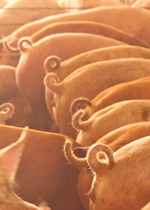
|
|
Consistency
Consistent Supply
As more and more American consumers are demanding natural meat from welfare friendly farms, Truebridge's first priority was to develop a welfare friendly habitat that could be adapted to many different types and sizes of American barns.
|
|
 |
|
 |
| Farms need to produce a consistent quantity of pigs. |
|
Large barns can be equally welfare compassionate. |
| |
 |
|
 |
| Consistent genetics and care produces similar pigs. |
|
When pigs are consistent the pork attributes are also. |
|
When asked to imagine a farm with happy animals, most people probably imagine a very small scale operation. A handful of pigs, cared for by a couple and their kids. That's because this is the only example many of us have been shown of well-treated farm animals. Happily, farms throughout Europe provide examples of barn designs that accommodate animal welfare on a larger scale, one that could supply a reasonably-sized market.
Grocery stores and restaurants need fresh pork every week, so most successful farms, big or small, try to produce a consistent number of market pigs each week. In most cases, it is more economical for a farmer to send their pigs to market in a livestock trailer. It takes 160-185 pigs to fill a livestock trailer and at least 600 sows to produce this quantity of pigs every week. On average, Truebridge farms each produce between one and three loads of this size, per week. Smaller farms can also be part of Truebridge, but they need to be located close enough to each other to share transportation costs.
Consistent Product
Because most Truebridge farms are large enough to produce a full load of pigs, that means the pork comes from a small number of family farmers who are all on the same page about how things should be done.
Truebridge farms all use the same genetics, give their pigs the same nutrition, shelter the pigs in similarly designed barns, and follow the same husbandry practices. This results in a high level of product consistency. From delivery to delivery, the cuts will have the dependable color, flavor, marbling, and size, with only a small amount of variation from season to season.
When pigs come from dozens of small farms, each contributing a few head, the pork differs wildly in its quality and characteristics, so it's difficult to know what to expect. This creates problems for the staff at the processing plant, who are challenged to create accurate cuts from pigs whose carcass sizes and fat cover are inconsistent. And it gives customers an uncertain cooking and dining experience.
|